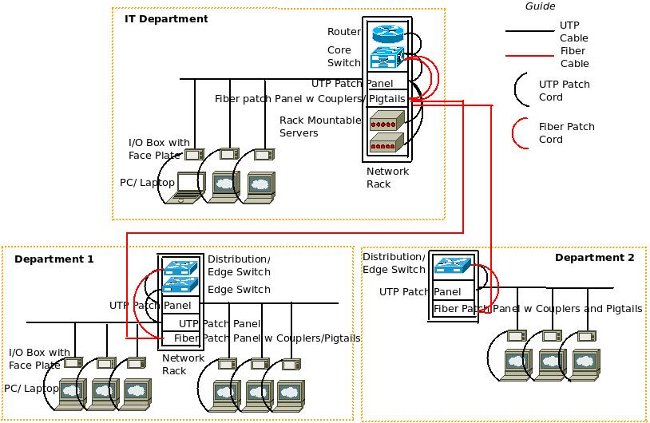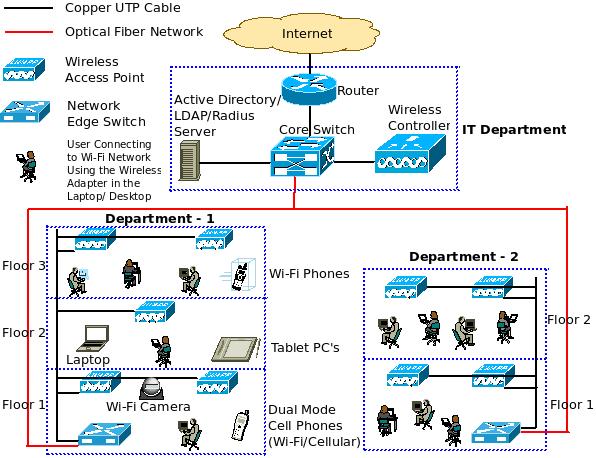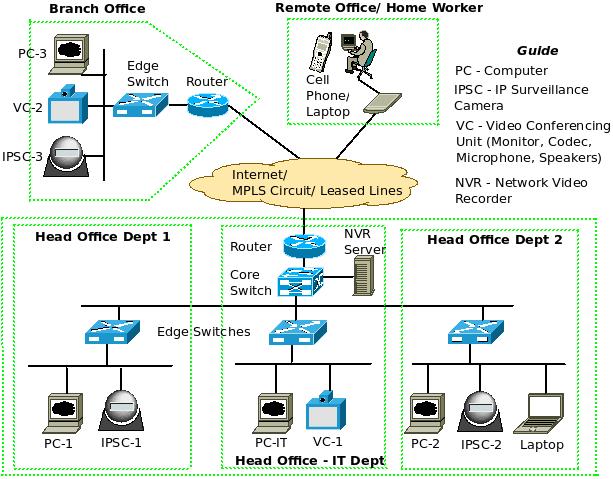What is a Converged IP Network?
A Converged IP Network today refers to the Unified Computer Network (LAN, based on IP) that uses multiple media (Wired, Wireless) to carry a variety of traffic types – Data, Voice, Video etc on a single network without the need for separate networks for each of them.
Why Converged IP Networks?
The Computer Networks (based on IP) are all pervasive today. Every department, building, branch of an organization requires and maintains a full fledged Local Area Network (LAN) for inter-connecting computers. The IP Network can operate on a variety of media – Copper, Fiber and wireless. So, since they have become inevitable and dominant, the other services (voice and data) have been redesigned to run on this network.The Phones can today plug in to the computer networks using RJ-45 Jacks and the IP Surveillance Cameras can also directly plug in to the computer network similarly. Not only on the hardware, but newer developments on the software (protocol) front as well as their standardization and international acceptance ensured that real time applications like voice and video can run along side data on a computer network and still give best quality if the Unified Communications strategy is planned properly and executed effectively.
There was another critical component of these services over IP networks that helped their mass adoption – Enabling newer features and tighter integration between data, voice and video applications. Think of this, an IP Telephony server can not only support most of the features of the existing EPABX, but can also add new and interesting features out of the box – Like Database/CRM integration for IVR enhancement, Call Recording, Meet Me Conference, Unified Communications capabilities, presence information, single number reach, adding video to a voice call etc. Similarly, a Video Conferencing system was able to call any other Video Conferencing system across the world simply if both sides just had a data connection to the Internet (via Internet Leased Lines) – This eliminated the requirement of dedicated PRI/ISDN lines at each location and also did not have the per minute call charges as most of the Internet bandwidth plans are negotiated on a yearly basis. IP Surveillance Cameras, similarly offered newer features like face recognition, license plate recognition, remote surveillance over the Internet, motion sensing, voice recording, video compression etc that were not hitherto available with DVR based systems.
So, for an organization implementing a green field project (new campus) today, a single computer network would be sufficient for all their communication needs. That means lesser cost/ lower implementation time for the various passive components that are required to form independent networks. More importantly, the operational and maintenance costs (of having to maintain three independent networks) comes down heavily.
What are the challenges ?
Well, before establishing a converged network, if the computer network has some problems, it will only affect the Internet usage and perhaps access to ERP/ application servers. You still had access to phones – so you could talk to anyone and you could monitor the video output of a DVR surveillance system. But once the network is converged, any major problem with the computer network would invariably affect all the services! And mind you, the computer network, if not planned and designed properly, can pose quite a few problems! For instance, a computer virus, network intrusion by hackers or Botnets would affect only your PC’s earlier, but now it can affect the phones as well! A well planed DoS (Denial Of Service) or a DDoS attack could choke the network devices badly and stop it from communicating any data – real time or otherwise! If the network capacity is not up to the mark, you could have delays while talking over the phone!
The investment needed to ensure that the computer network can handle the excessive load generated by the real time applications like voice and video could be quite high like the investment needed to secure all the network devices within the LAN. The cost of building redundant active components and passive paths to keep the network even 99% up could be very formidable!
In spite of the challenges, the converged network could very much become a reality if the implementation of the network and the services were planned properly and executed efficiently. This should be in tune with the business processes – meaning the network ought to help reduce ongoing recurring costs and also help create new revenue opportunities for the organizations employing them. That, is the real strength of Converged Networks! And what better platform to make it all happen than the IP?
Components of a Converged IP Network:
There are four main components of a Converged IP Network: The Computer Network itself with all the active and passive components required to build the Wired IP Network, Wireless Networks, Voice Over IP (IP Telephony) and Video Over IP Systems (Video Surveillance and Video Conferencing).
As the old adage goes that a diagram is equivalent to 1000 words, we have given the architecture diagram for each of the components of a converged network below. And if you want to read those 1000 words, just click on the text links given below each diagram for a brief overview on each of them.
Basic Network Connectivity Diagram – Active and Passive Network Components:

Wireless (Wi-Fi) Network – Architecture Diagram:

Voice Over IP (IP Telephony) – Architecture Diagram

Video Over IP (Video Conferencing and Video Surveillance) – Architecture Diagram:

excITingIP.com
In case you may have any questions or want to add some information, you could use submit the same in the comments section below. You could also use the Contact Form to contact us. If you want to follow topics such as these regularly from this website, you could submit your email address in the box mentioned “Get e-mail updates when new articles are published”
A converged network optimizes your infrastructure resources and brings countless efficiencies to your operations. But if it is not properly planned and designed, it can cause many issues and headaches. As to all complicated efforts, the secret to a successful converged networkproject is in the preparation.
Hello, I am producing an installation manual titled PBX INSTALLATION TECHNICIAN and would like to show the readers one of your diagram titled VOICE OVER IP ARCH. DIAGRAM?
May I have your permission to show this diagram?
I will provide credits and thanks.
Steve
this is very detailed information, it will help me to be more clear in this subject. waiting for more..